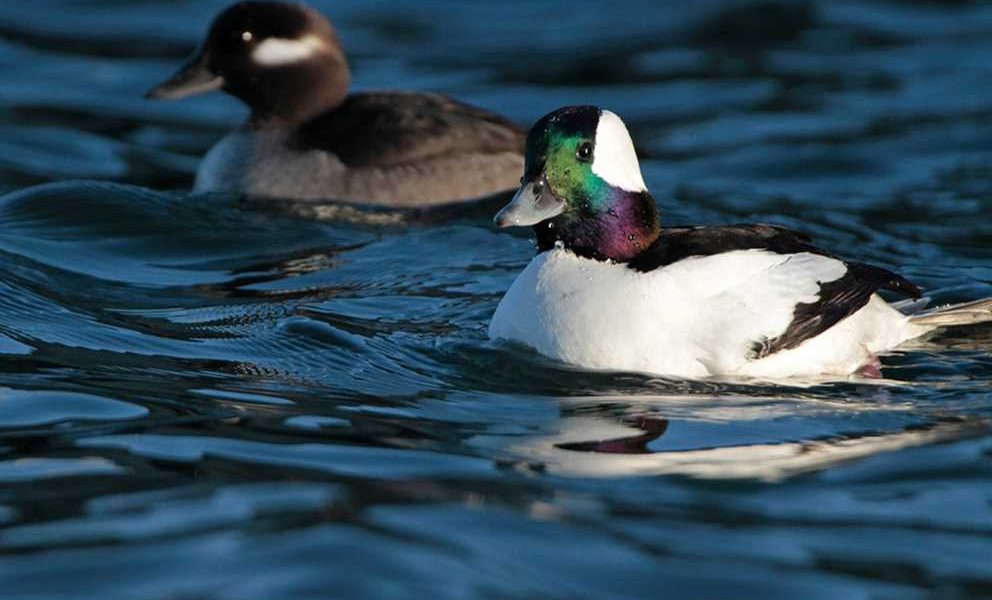This past Monday, as I was rushing home across the Pulaski Bridge, the Newtown Creek below seemed so dirty that I stopped to look from the bridge. It was a bright and warm January afternoon, and the light penetrated the translucent waters to reveal an unusually large number of shapeless objects floating just beneath the surface: pale sheets of plastics, bottle caps, discarded containers. As I watched, fascinated by the slow dance of the trash in the current, I noticed two small ducks, swimming among the detritus. One was brown. The other one was jet black with a white band along the wings and the sides of the head.
Their delicate beauty seemed impossible in Newtown Creek, a waterway punished by two centuries of industrial development along its plus-11 miles of shoreline. As I tried to get a better look at the lovely couple, I saw the black and white bird dive in and disappear in the gloomy water. Long seconds passed. This little bird was an impressive diver like its much larger cousin, the cormorant. It finally popped up in the brownish surface and graciously swam back next to its partner. Although I was in a hurry, I stayed there looking at the two of them, feeding in what I thought to be one of the scariest underwater habitats any animal could conceived. These creatures weren’t just unbelievably cute—they were also tough survivors.
Back home, it wasn’t hard to identify the birds. After Googling ‘diving duck Newtown Creek,’ I clicked on the link published by the Newtown Creek Alliance, the very first one on the list of results. The downloaded poster showed the names and pictures of some of the bird species that make this waterway and its surrounding area their permanent or temporary habitat. And there it was, third on the top row, just below the title, right between the great black-backed gull and the American kestrel: the elegant silhouette of the Bufflehead, one of the smallest ducks in North American. The blue color-coded frame of the picture revealed that the bird was a winter resident of Newtown Creek. This was all the confirmation I needed: the Bufflehead, Bucephala albeola, was definitely the bitonal diver extraordinaire I saw from the bridge.
Photos on my screen revealed gem-like details that I couldn’t see from my vantage point, like the iridescent dark plumage around the snowy patch on its head or the short, smiling grey beak. Sexual dimorphism is very common in ducks, and the small Bucephala albeola is no exception. The more modest brown plumage I saw on the other Newtown Creek little duck, I now know, is characteristic of the female of the species, who also feature a small white spot on the sides of the head.
When I saw the two birds together, I immediately assumed that they were a couple. Sometimes we cannot help but identify our own behavior in other animals, and the way these two creatures swam next to each other seemed to indicate a special bond. Now I know I was probably right: Buffleheads are one of the few monogamous duck species. For all we know, these two may have been together for years, punctually flying together from northern Canada to spend the winters here in New York City, hunting crustaceans and mollusks in the muddy, polluted bottom of Newtown Creek, nesting in abandoned poplar or aspen cavities dug by northern flickers or woodpeckers, competing with bigger ducks for refuge, flying back to their breeding grounds in the north, avoiding hawks and eagles and even dodging birdshot along the coastline: a years-long partnership to survive in a harsh environment made harsher by us.
The following Friday, I went over the bridge again, hoping to spot another Bufflehead swimming on the creek. The air was bitterly cold, but the sun shone high in the sky. In contrast to the prior week, this was a typical January day and the water below the bridge, ruffled by sharp gusts, seemed much cleaner. At least there were no obvious pieces of rubbish floating on its surface, which made it that much easier to believe that the water in New York Harbor, despite the raw sewage it still gets when the rain overwhelms the water treatment plants and the years of chemical spillings in Newtown Creek, has never been this clean in a hundred years. Then as I reached the outlook on the bridge, I saw a Bufflehead swimming almost directly below me. Even though I was far above, the little drake cautiously moved away as soon as he noticed my presence, leaving behind a soft delta-shaped wake. Then I noticed a little group of four birds further away, near the boats moored on the Queens side, swimming in his direction. As they got closer, it became apparent that they were also Buffleheads, all of them males. Once they met in the middle of the creek, they swam together to a spot on the Brooklyn side, just west of the North Brooklyn Boat Club dock to the left of my position. Four of them dove down and one stayed alert on the surface. Then he went down as the rest of them resurfaced. And I stood there watching the black and white little bodies disappear and appear on the dark surface for as long as I could bear the cold. Resilience, I thought, truly is a beautiful thing.



